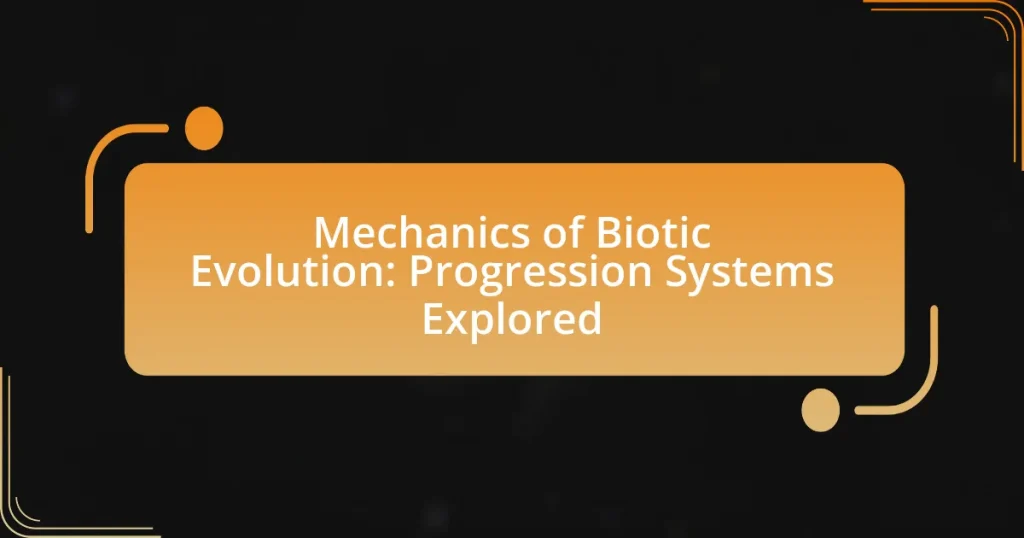The article focuses on the mechanics of biotic evolution, detailing key processes such as natural selection, genetic drift, mutation, and gene flow, which drive evolutionary changes in species over time. It explores how these mechanisms influence species development, adaptation, and biodiversity, highlighting the impact of environmental factors and human activities on evolutionary processes. Additionally, the article examines different progression systems in biotic evolution, including phyletic gradualism and adaptive radiation, and discusses the implications of understanding these mechanics for conservation efforts and ecological balance. Through a comprehensive analysis, the article underscores the significance of genetic variation and external influences in shaping the evolutionary trajectory of organisms.

What are the Mechanics of Biotic Evolution?
The mechanics of biotic evolution involve processes such as natural selection, genetic drift, mutation, and gene flow. Natural selection, first articulated by Charles Darwin, is the mechanism by which individuals with advantageous traits are more likely to survive and reproduce, thereby passing those traits to future generations. Genetic drift refers to random changes in allele frequencies within a population, which can lead to significant evolutionary changes over time, especially in small populations. Mutations introduce new genetic variations, providing the raw material for evolution, while gene flow, the transfer of genetic material between populations, can alter allele frequencies and increase genetic diversity. These mechanisms collectively drive the evolutionary changes observed in species over time, as evidenced by numerous studies in evolutionary biology that demonstrate their roles in shaping biodiversity.
How do biotic evolution mechanics influence species development?
Biotic evolution mechanics significantly influence species development by driving genetic variation and adaptation through processes such as natural selection, mutation, and gene flow. Natural selection favors traits that enhance survival and reproduction, leading to the gradual adaptation of species to their environments. For instance, the peppered moth in England evolved darker coloration during the Industrial Revolution due to increased pollution, which provided better camouflage against predators. Additionally, mutations introduce new genetic variations, some of which may confer advantages in changing environments, while gene flow allows for the exchange of genetic material between populations, enhancing diversity and resilience. These mechanisms collectively shape the evolutionary trajectory of species, ensuring their survival and adaptation over time.
What are the key processes involved in biotic evolution?
The key processes involved in biotic evolution are natural selection, genetic drift, mutation, and gene flow. Natural selection is the mechanism by which individuals with advantageous traits are more likely to survive and reproduce, leading to the gradual adaptation of populations. Genetic drift refers to random changes in allele frequencies within a population, which can significantly impact small populations. Mutation introduces new genetic variations into a population’s gene pool, providing the raw material for evolution. Gene flow, the transfer of genetic material between populations, can alter allele frequencies and increase genetic diversity. These processes collectively drive the evolution of species over time, as evidenced by the observed changes in species traits and genetic makeup in response to environmental pressures and isolation.
How do environmental factors impact these processes?
Environmental factors significantly influence the processes of biotic evolution by shaping the selective pressures that organisms face. For instance, changes in climate, habitat availability, and resource distribution can lead to variations in survival and reproduction rates among species. A study published in the journal “Nature” by Parmesan and Yohe (2003) demonstrated that climate change has already affected species distributions and phenology, illustrating how environmental shifts can drive evolutionary adaptations. These adaptations may include changes in morphology, behavior, and reproductive strategies, ultimately leading to speciation or extinction events.
Why is understanding biotic evolution important?
Understanding biotic evolution is important because it provides insights into the mechanisms that drive biodiversity and the adaptation of species over time. This understanding helps scientists predict how organisms will respond to environmental changes, which is crucial for conservation efforts and managing ecosystems. For instance, research indicates that species with a clear evolutionary history are more resilient to climate change, as evidenced by studies showing that genetic diversity within populations correlates with survival rates in changing environments.
What implications does biotic evolution have for biodiversity?
Biotic evolution significantly enhances biodiversity by driving the emergence of new species and ecological interactions. As organisms adapt to changing environments, they undergo speciation, which increases the variety of life forms within ecosystems. For instance, the adaptive radiation of Darwin’s finches in the Galápagos Islands illustrates how evolutionary processes can lead to a wide range of species adapted to different niches, thereby enriching biodiversity. Furthermore, biotic evolution fosters genetic diversity within populations, which is crucial for resilience against environmental changes and diseases. This genetic variation allows species to adapt over time, ensuring their survival and the stability of ecosystems.
How does biotic evolution relate to ecological balance?
Biotic evolution directly influences ecological balance by shaping species diversity and interactions within ecosystems. As species evolve, they adapt to their environments, which can lead to changes in population dynamics, resource availability, and predator-prey relationships. For instance, the evolution of certain plant species can affect herbivore populations, which in turn impacts the entire food web. Research indicates that ecosystems with higher biodiversity, resulting from biotic evolution, tend to be more resilient to disturbances, as diverse species can fulfill various ecological roles. This interconnectedness highlights the importance of evolutionary processes in maintaining ecological stability and health.

What are the Different Progression Systems in Biotic Evolution?
The different progression systems in biotic evolution include phyletic gradualism, punctuated equilibrium, and adaptive radiation. Phyletic gradualism posits that species evolve through a slow, continuous process of change over time, as seen in the fossil record of horses. Punctuated equilibrium, proposed by Stephen Jay Gould and Niles Eldredge, suggests that species remain relatively unchanged for long periods, interrupted by brief, rapid changes during speciation events. Adaptive radiation occurs when a single ancestral species rapidly diversifies into a variety of forms to adapt to different environments, exemplified by Darwin’s finches in the Galápagos Islands. These systems illustrate the various mechanisms through which evolutionary change can occur in biological organisms.
How do progression systems categorize evolutionary changes?
Progression systems categorize evolutionary changes by classifying them into distinct tiers or stages that reflect the complexity and adaptability of organisms over time. These systems often utilize frameworks such as linear progression, branching evolution, or adaptive radiation to illustrate how species evolve in response to environmental pressures and genetic variations. For instance, the concept of adaptive radiation demonstrates how a single ancestral species can diversify into multiple forms, each adapted to specific ecological niches, thereby providing a clear categorization of evolutionary changes based on functional adaptations and survival strategies.
What are the main types of progression systems?
The main types of progression systems are linear progression, non-linear progression, and exponential progression. Linear progression involves a straightforward advancement where each step builds directly on the previous one, commonly seen in traditional leveling systems in games. Non-linear progression allows for multiple paths and choices, enabling players to advance in various ways, often found in open-world games. Exponential progression refers to a system where growth accelerates over time, leading to rapid increases in power or abilities, frequently utilized in role-playing games to create a sense of significant advancement. Each type serves distinct gameplay mechanics and player experiences, contributing to the overall design of biotic evolution in gaming contexts.
How do these systems interact with genetic variation?
Biotic evolution systems interact with genetic variation through mechanisms such as natural selection, genetic drift, and gene flow. Natural selection acts on genetic variation by favoring alleles that confer advantageous traits, thereby increasing their frequency in a population over generations. Genetic drift, particularly in small populations, can lead to random changes in allele frequencies, which may result in the loss of genetic variation. Gene flow introduces new genetic material into a population, enhancing genetic diversity and potentially altering the evolutionary trajectory. These interactions are crucial for understanding how species adapt and evolve in response to environmental pressures.
What role does natural selection play in progression systems?
Natural selection serves as a fundamental mechanism driving the evolution of progression systems by favoring traits that enhance survival and reproduction. In biological contexts, organisms with advantageous traits are more likely to thrive and pass those traits to future generations, leading to gradual adaptations within populations. For example, in a study by Endler (1986) on guppy populations, it was demonstrated that predation pressure led to the selection of coloration patterns that improved camouflage, illustrating how natural selection shapes traits that contribute to an organism’s fitness in specific environments. This process results in the emergence of complex traits and behaviors that define the progression of species over time.
How does natural selection drive evolutionary change?
Natural selection drives evolutionary change by favoring individuals with advantageous traits that enhance their survival and reproductive success in a given environment. This process leads to the gradual adaptation of populations over generations, as these beneficial traits become more common. For example, in a study of the peppered moth, researchers observed that darker moths had a survival advantage in polluted environments, leading to an increase in their population over time. This illustrates how natural selection can result in significant changes in species characteristics, ultimately shaping the course of evolution.
What are examples of natural selection in action?
Examples of natural selection in action include the peppered moth, antibiotic resistance in bacteria, and Darwin’s finches. The peppered moth demonstrates natural selection as its coloration shifted from light to dark during the Industrial Revolution due to pollution, which favored darker moths that were less visible to predators. Antibiotic resistance in bacteria illustrates natural selection as bacteria evolve to survive antibiotic treatments, leading to strains that are increasingly difficult to treat. Darwin’s finches showcase natural selection through variations in beak size and shape, which adapted to different food sources on the Galápagos Islands, influencing survival and reproduction rates. These examples provide clear evidence of how environmental pressures drive evolutionary changes in species.

How do External Factors Affect Biotic Evolution Mechanics?
External factors significantly influence biotic evolution mechanics by altering environmental conditions, which in turn affects natural selection and species adaptation. For instance, climate change can lead to habitat loss, forcing species to adapt or face extinction, as seen in the case of polar bears, which are increasingly threatened by melting ice caps. Additionally, factors such as food availability, predation pressures, and human activities like deforestation and pollution can create selective pressures that drive evolutionary changes. Research indicates that these external factors can accelerate evolutionary processes, as demonstrated by the rapid adaptation of certain species to urban environments, showcasing the dynamic interplay between external influences and evolutionary mechanics.
What environmental changes impact biotic evolution?
Environmental changes such as climate shifts, habitat alterations, and the introduction of invasive species significantly impact biotic evolution. Climate shifts, for instance, can lead to changes in temperature and precipitation patterns, which affect species distribution and survival. Habitat alterations, including deforestation and urbanization, can disrupt ecosystems and force species to adapt or face extinction. The introduction of invasive species can outcompete native species for resources, leading to evolutionary pressures that shape the traits of the affected organisms. These changes create selective pressures that drive natural selection, influencing genetic variation and ultimately leading to evolutionary adaptations.
How do climate shifts influence species adaptation?
Climate shifts influence species adaptation by altering environmental conditions, which can lead to changes in habitat, food availability, and reproductive patterns. For instance, as temperatures rise, species may migrate to cooler areas or undergo physiological changes to survive in new conditions. Research indicates that species with shorter generation times, such as bacteria and insects, can adapt more rapidly to climate changes compared to larger organisms. A study published in “Nature” by Parmesan and Yohe (2003) found that 62% of species studied showed significant shifts in their geographic ranges due to climate change, demonstrating the direct impact of climate shifts on species adaptation.
What role do human activities play in biotic evolution?
Human activities significantly influence biotic evolution by altering habitats, introducing invasive species, and driving climate change. These actions can lead to changes in species composition, genetic diversity, and evolutionary pressures. For instance, habitat destruction through deforestation and urbanization reduces available niches, forcing species to adapt or face extinction. Additionally, the introduction of non-native species can disrupt local ecosystems, leading to competition and hybridization, which can accelerate evolutionary changes. Climate change, driven by human activities, alters temperature and precipitation patterns, impacting species’ survival and reproduction rates. Research indicates that these factors contribute to rapid evolutionary changes, as seen in studies of urban wildlife adapting to human environments.
How do genetic mutations contribute to evolution?
Genetic mutations contribute to evolution by introducing new genetic variations into a population, which can lead to changes in traits over generations. These mutations can occur spontaneously during DNA replication or be induced by environmental factors. For example, a study published in the journal “Nature” by researchers at the University of California, Berkeley, demonstrated that mutations in the gene responsible for pigmentation in certain species of mice resulted in variations that enhanced their camouflage in different environments, thereby increasing their survival and reproductive success. This process of natural selection acts on the variations created by mutations, driving evolutionary change.
What types of mutations are most significant in evolution?
Point mutations, insertions, and deletions are the most significant types of mutations in evolution. Point mutations can lead to changes in a single amino acid in a protein, potentially altering its function, which can affect an organism’s fitness. Insertions and deletions can cause frameshift mutations, leading to significant changes in protein structure and function. These mutations contribute to genetic diversity, which is essential for natural selection and adaptation. For instance, the emergence of antibiotic resistance in bacteria is often due to point mutations that confer survival advantages in the presence of antibiotics, demonstrating the direct impact of these mutations on evolutionary processes.
How do mutations interact with environmental pressures?
Mutations interact with environmental pressures by providing genetic variations that can enhance or diminish an organism’s fitness in a specific environment. When environmental pressures, such as climate change, predation, or resource availability, act on a population, mutations that confer advantageous traits may increase in frequency through natural selection. For instance, the peppered moth’s color mutation allowed it to better blend into its soot-darkened environment during the Industrial Revolution, leading to increased survival rates. This demonstrates that mutations can directly influence evolutionary outcomes by enabling organisms to adapt to changing conditions.
What are the practical implications of understanding biotic evolution mechanics?
Understanding biotic evolution mechanics has significant practical implications in fields such as conservation biology, agriculture, and medicine. For instance, knowledge of evolutionary processes allows conservationists to develop strategies that enhance biodiversity and ecosystem resilience, as evidenced by the application of evolutionary principles in habitat restoration projects that have successfully increased species survival rates. In agriculture, understanding how crops evolve in response to environmental pressures enables the development of more resilient and productive varieties, which is crucial for food security, particularly in the face of climate change. Additionally, in medicine, insights into the evolution of pathogens inform vaccine development and treatment strategies, as seen in the rapid adaptation of viruses like influenza, which necessitates ongoing research and adaptation of vaccines to maintain effectiveness. These examples illustrate that a comprehensive understanding of biotic evolution mechanics directly informs practical applications that address real-world challenges.
How can this knowledge inform conservation efforts?
Understanding the mechanics of biotic evolution can significantly inform conservation efforts by providing insights into species adaptation and ecosystem resilience. This knowledge allows conservationists to identify which species are most vulnerable to environmental changes and how they might adapt over time. For example, studies have shown that species with higher genetic diversity are more likely to survive and adapt to changing conditions, as evidenced by the resilience of certain populations during climate shifts. By applying this understanding, conservation strategies can prioritize the protection of genetically diverse populations and habitats that support evolutionary processes, ultimately enhancing the effectiveness of conservation initiatives.
What strategies can be employed to mitigate negative impacts on evolution?
Strategies to mitigate negative impacts on evolution include habitat conservation, genetic diversity enhancement, and pollution reduction. Habitat conservation protects ecosystems, ensuring species have the necessary environments to thrive, as evidenced by the success of protected areas in preserving biodiversity. Enhancing genetic diversity through breeding programs can increase resilience to diseases and environmental changes, supported by studies showing that diverse populations are more adaptable. Pollution reduction minimizes harmful effects on species and ecosystems, with research indicating that cleaner environments lead to healthier populations and improved evolutionary outcomes.



